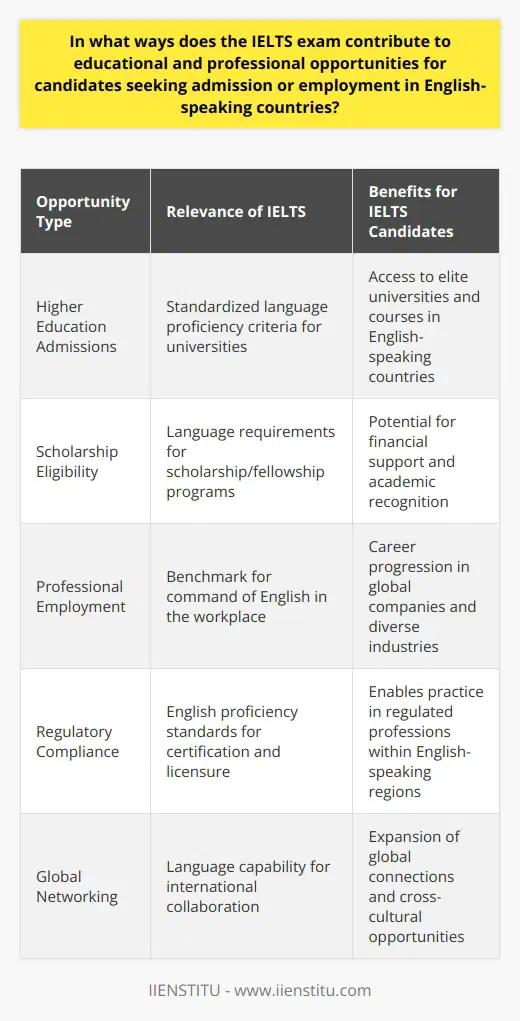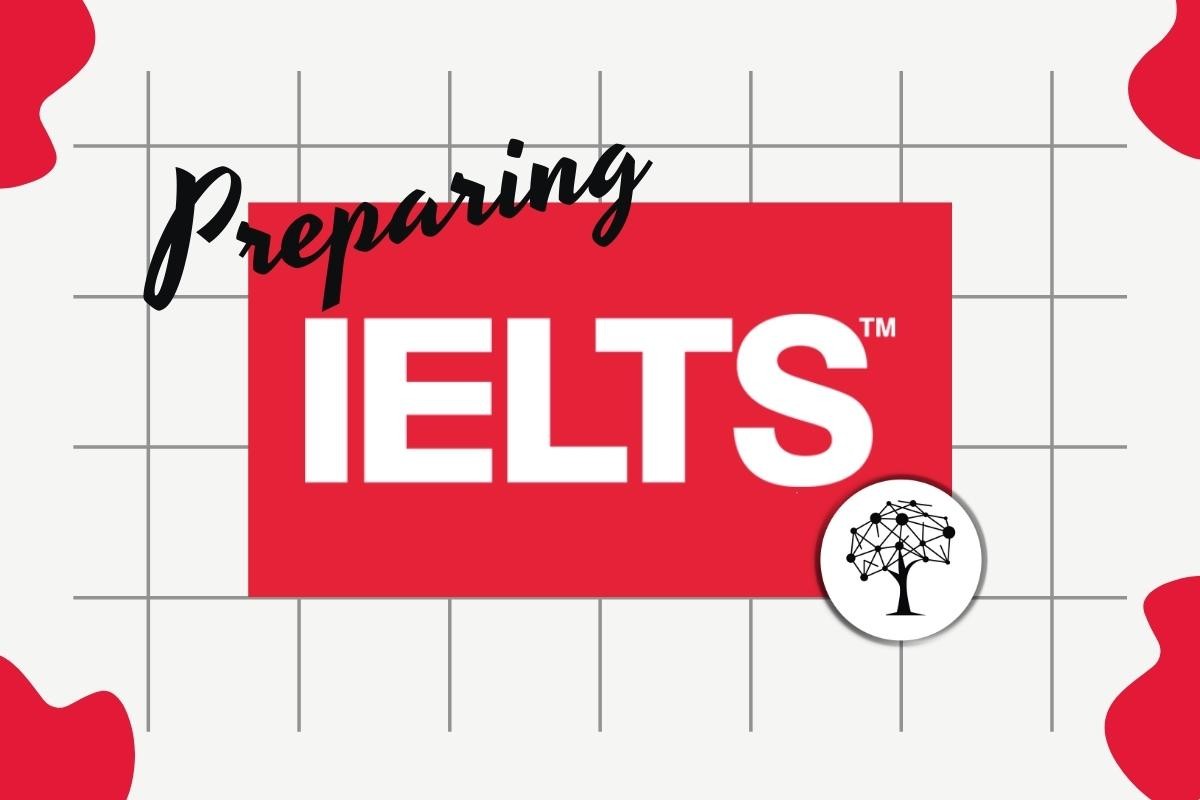
The Writing section of the test is designed to test the ability to write an essay or a letter in English. The Speaking section of the test is designed to test the ability to communicate in English.
The International English Language Testing System (IELTS) is a widely used test to assess the language skills of listening, reading, writing, and speaking. It has two versions: IELTS Academic and IELTS General Training, which are used by universities, employers, and immigration authorities in Australia, Canada, New Zealand, and the UK. The IELTS test consists of four sections: Listening, Reading, Writing, and Speaking.
The main difference between IELTS Academic and IELTS General Training is the content of the Reading and Writing sections. The Listening, Reading, Writing, and Speaking sections are designed to test the ability to understand and communicate in English.
Introduction
Overview of IELTS
Differences between IELTS Academic and IELTS General Training
Assessed Language Skills
Availability of Tests
Introduction
English language tests are vital to studying, working, and migrating to English-speaking countries. The International English Language Testing System (IELTS) is one of the most widely used tests. This test is used by universities, employers, and immigration authorities in Australia, Canada, New Zealand, and the UK. It assesses the four language skills of listening, reading, writing, and speaking.
Overview of IELTS
IELTS is an English language test with two versions: IELTS Academic and IELTS General Training. IELTS Academic is for people wanting to study at a higher education level in an English-speaking environment, while IELTS General Training is for those applying to study below a degree level, for work experience, or for migration to Australia, Canada, New Zealand, and the UK.
The IELTS test consists of four sections: Listening, Reading, Writing, and Speaking. Each section is scored on a scale of 0 to 9. The total score is then calculated by combining the scores from each section.
Differences between IELTS Academic and IELTS General Training
The main difference between IELTS Academic and IELTS General Training is the content of the Reading and Writing sections. The Reading section of IELTS Academic tests the ability to understand academic texts. In contrast, the Reading section of IELTS General Training is designed to test the ability to understand general texts. The Writing section of IELTS Academic tests the ability to write an essay on a given topic. In contrast, the Writing section of IELTS General Training tests the ability to write a letter or report on a given topic.
Assessed Language Skills
IELTS assesses the four language skills of listening, reading, writing, and speaking. The Listening section of the test is designed to test the ability to understand spoken English in a variety of contexts. The Reading section of the test is designed to test the ability to understand written English in a variety of contexts. The Writing section of the test is designed to test the ability to write English in a variety of contexts. The Speaking section of the test is designed to test the ability to communicate in English in a variety of contexts.
Availability of Tests
IELTS Academic is available on paper, computer, and online, while IELTS General Training is available on paper and computer only. The paper-based test is available in over 140 countries, while the computer-based test is available in over 50 countries. The online test is available in over 30 countries.
Conclusion
The International English Language Testing System (IELTS) is an English language test that is used by universities, employers, and immigration authorities in Australia, Canada, New Zealand, and the UK. It assesses the four language skills of listening, reading, writing, and speaking.
IELTS Academic is for people wanting to study at a higher education level in an English-speaking environment, while IELTS General Training is for those applying to study below a degree level, for work experience, or for migration to Australia, Canada, New Zealand, and the UK. IELTS Academic is available on paper, computer, and online, while IELTS General Training is available on paper and computer only.
IELTS is the key to unlocking your potential to communicate across cultures and nations.
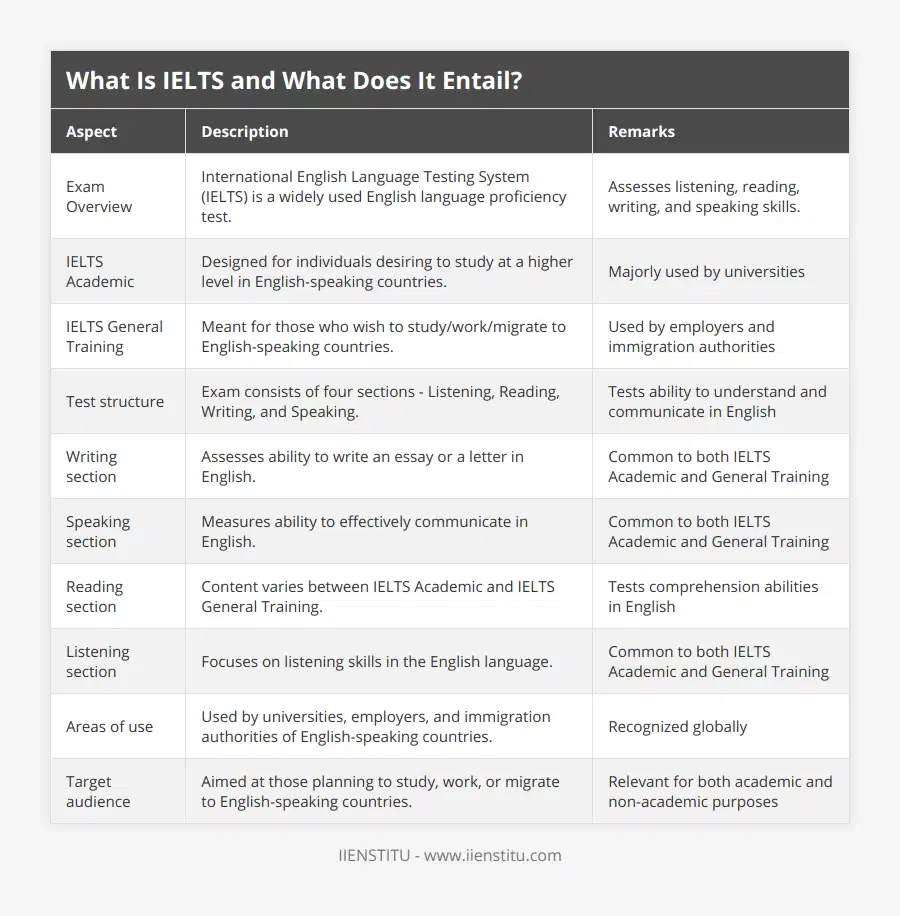
Frequently Asked Questions
What are the language skills assessed in the IELTS test?
The language skills assessed in the IELTS test are listening, reading, writing, and speaking.
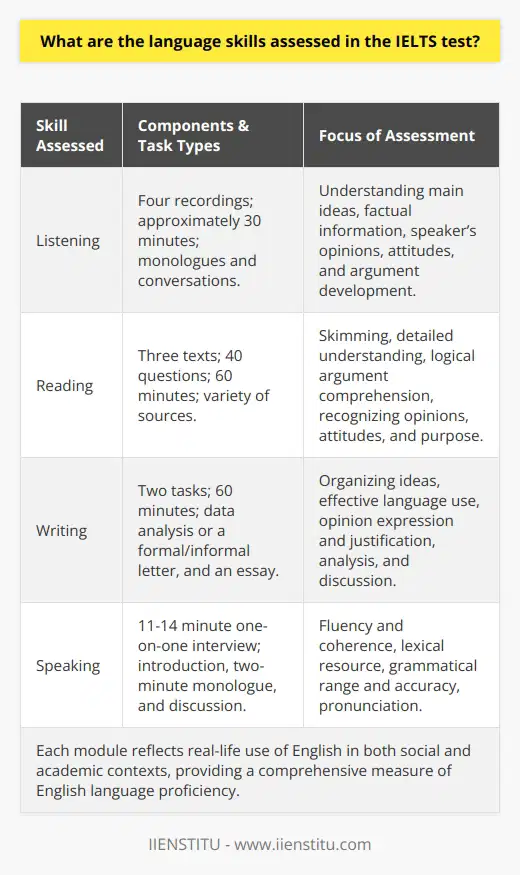
What is the difference between IELTS Academic and IELTS General Training?
The main difference between IELTS Academic and IELTS General Training is that the content of the Reading and Writing sections is different. IELTS Academic tests academic language and content, while IELTS General Training tests general language and content. The Listening, Reading, Writing, and Speaking sections of both tests are designed to assess the ability to understand and communicate in English.
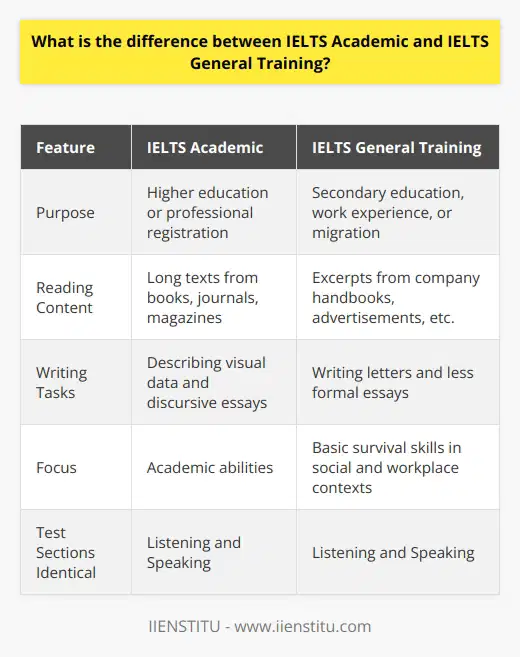
How often are IELTS tests available?
IELTS tests are available regularly, with multiple test dates available each month.

What does the IELTS test consist of?
IELTS Test Components
The IELTS test, or International English Language Testing System, is a standardized examination designed to evaluate an individual's proficiency in the English language. This test consists of four primary components, which assess various aspects of one's linguistic abilities.
Listening Section
The listening section consists of 40 questions, spread across four recorded conversations and monologues. Test-takers must demonstrate their ability to understand main ideas, specific details, and speakers' opinions in various contexts and accents.
Reading Section
In the reading section, candidates must read three texts of varying difficulty and answer 40 questions within 60 minutes. This portion evaluates their capacity to grasp the main ideas, extract specific information, and understand the writer's opinions and purposes.
Writing Section
The writing section requires test-takers to complete two tasks within 60 minutes. The tasks involve presenting a clear, well-organized argument, responding to a specific problem or question, and using accurate grammar, spelling, and vocabulary.
Speaking Section
The speaking section involves a face-to-face conversation with an IELTS examiner, lasting approximately 11-14 minutes. It entails expressing oneself fluently, accurately, and coherently on various topics while demonstrating a wide range of vocabulary and grammatical structures.
In conclusion, the IELTS test is a comprehensive assessment of one's English language abilities in listening, reading, writing, and speaking. It serves as a benchmark for educational institutions, employers, and immigration authorities to gauge the linguistic competence of individuals in an academic or professional context.
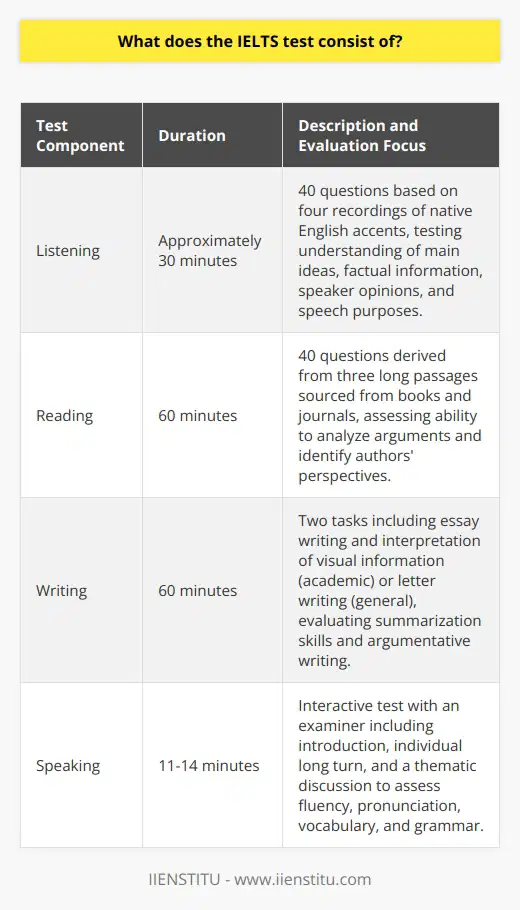
Is the IELTS exam difficult?
IELTS Exam Difficulty
Understanding the IELTS Exam
Analyzing the difficulty of the International English Language Testing System (IELTS) exam requires an understanding of its purpose and structure. The IELTS assesses a test-taker's English language proficiency through four different sections, namely Listening, Reading, Writing, and Speaking. These sections measure the candidates' abilities and ensure they can function effectively in English-speaking environments. Therefore, the complexity of the exam is subjective, as it relies on the candidate's familiarity and skill level with the English language.
Exam Preparation and Test Anxiety
A significant factor contributing to the perceived difficulty of the IELTS exam is test-taker anxiety. This anxiety results from inadequate preparation, unfamiliarity with the test's format or content, and high expectations. Minimizing anxiety, however, can be accomplished through comprehensive preparation, understanding the format of the exam, and familiarizing oneself with question types. Furthermore, practicing time management and stress reduction techniques can play a role in improving performance, thereby reducing the perceived difficulty of the test.
Variability of Exam Versions
It is essential to consider the different versions of the IELTS exam, the Academic and General Training versions. The Academic IELTS is designed for individuals seeking higher education, whereas the General Training IELTS caters to those aiming for work experience or migration to English-speaking countries. Vocabulary and language skills required for both versions vary widely, as Academic modules focus on complex, scholastic language, while General Training modules use everyday language. This variation in language complexity highlights the potential differences in perceived difficulty levels for diverse test takers.
Individual Skill Levels and Proficiency
Lastly, the difficulty of the IELTS exam is subjective, depending on individual test-takers' background, experience, and proficiency with the English language. Test-takers who have grown up in English-speaking environments or have extensive exposure to English may find the exam less challenging. On the other hand, individuals with limited English language skills or unfamiliarity with different accents may struggle with some sections, such as Listening or Speaking.
Conclusion
Overall, while the IELTS exam may be challenging for some test-takers, its difficulty largely depends on one's familiarity with the English language, the version of the test, test anxiety, and the level of adequate preparation. By addressing these factors, candidates can significantly improve their performance on the IELTS exam, making their experience less stressful and challenging.
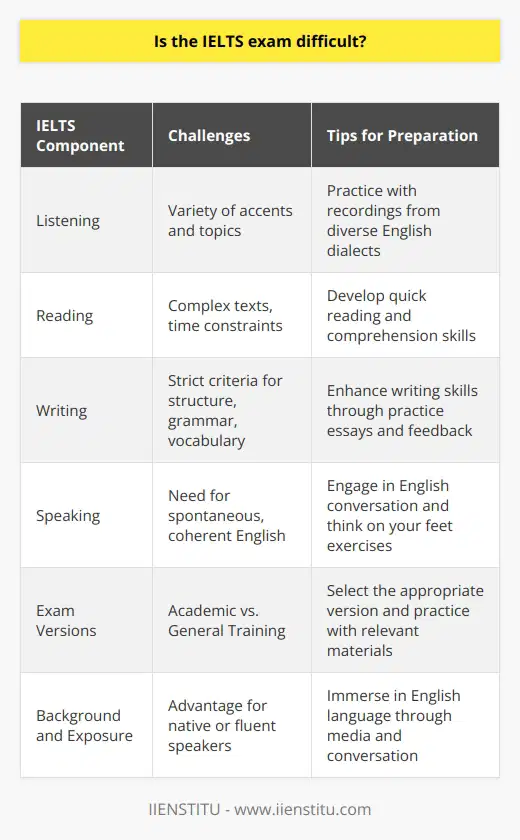
What is the IELTS passing score?
IELTS Score Requirements
The International English Language Testing System (IELTS) does not have a specific passing score, as the required bands depend on the purpose or institution where the test-taker seeks admission. The IELTS score ranges from 0 to 9, with each band reflecting a different level of English proficiency.
University Programs
For university programs, a common minimum overall score is 6.0, with at least 5.5 in individual skills (reading, writing, listening, and speaking). Different universities and faculties, however, have varying requirements, with some demanding higher scores in specific areas.
Professional Registration
Professional registration bodies may also set their own IELTS score requirements. For instance, healthcare professionals – such as nurses and doctors – typically need to achieve an overall score of 7.0 with a minimum of 6.5 in each section to practice in English-speaking countries.
Migration and Visas
For migration or visa purposes, specific countries establish their own thresholds. For example, in Australia, skilled migrants seeking a permanent visa must score at least 6.0 in each skill, while Canada's Express Entry immigration system assigns points based on proficiency levels, with higher bands resulting in more points.
Workplace Requirements
Employers, too, have preferences for IELTS scores. While some businesses are content with candidates achieving an overall band of 5.0 or 5.5, others may stipulate a minimum of 6.0 or even 7.0, depending on the nature of the position and necessary communication skills.
Improving Readability
It is crucial to understand the specific IELTS score requirements for the target institution, organization, or country to set realistic goals and assess the necessary preparation. Knowing these requirements will help test-takers focus their efforts to enhance their English proficiency and achieve the desired outcome.
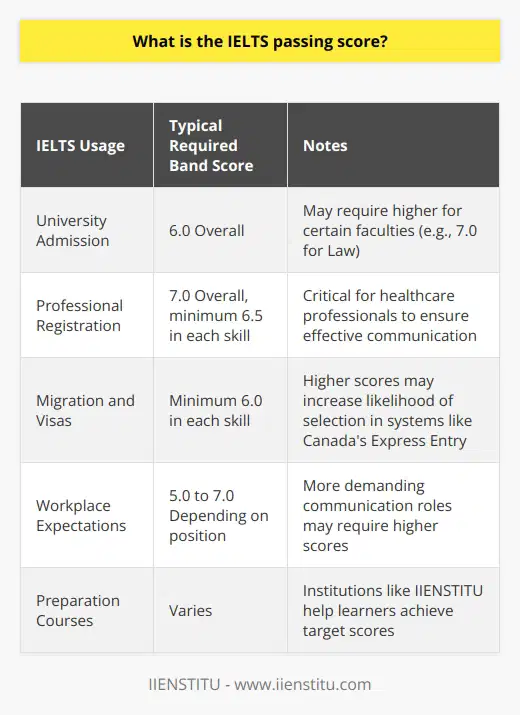
What is IELTS and for what purpose is it utilized?
Understanding IELTS
The International English Language Testing System (IELTS) is a standardized English proficiency test that assesses a candidate's linguistic abilities in reading, writing, listening, and speaking. It is administered by the British Council, IDP: IELTS Australia, and Cambridge English Language Assessment.
Purpose of IELTS
The primary purpose of the IELTS test is to evaluate the English proficiency of non-native English speakers. It is utilized for a range of reasons, including academic, professional, and migration purposes.
Academic Requirements
In the context of higher education, universities and colleges across the globe often require international students to provide IELTS scores. These scores are integral in determining a student's language competence, as it is crucial for them to comprehend and communicate effectively within an English-speaking environment.
Professional Advancements
In the professional realm, IELTS scores are frequently requested by employers seeking to hire candidates from non-English speaking backgrounds. This is to ensure that the potential employee can efficiently perform tasks that require English communication, both written and oral.
Migration Necessities
For immigration to English-speaking countries like Australia, Canada, New Zealand, and the United Kingdom, IELTS scores are a key component of the application process. The immigration authorities in these countries utilize the test results to evaluate the applicant's ability to integrate into society and contribute effectively to the workforce.
Test Formats
There are two types of IELTS exams – the General Training and the Academic. The General Training version is tailored to assess the basic survival skills in broad social and workplace environments, while the Academic version appraises language skills needed for tertiary education and professional settings.
In conclusion, the IELTS test plays a crucial role in evaluating the English language proficiency of individuals worldwide. With its utilization in academic, professional, and migration contexts, it serves as a reliable and widely-accepted means for assessing a candidate's English language competence.
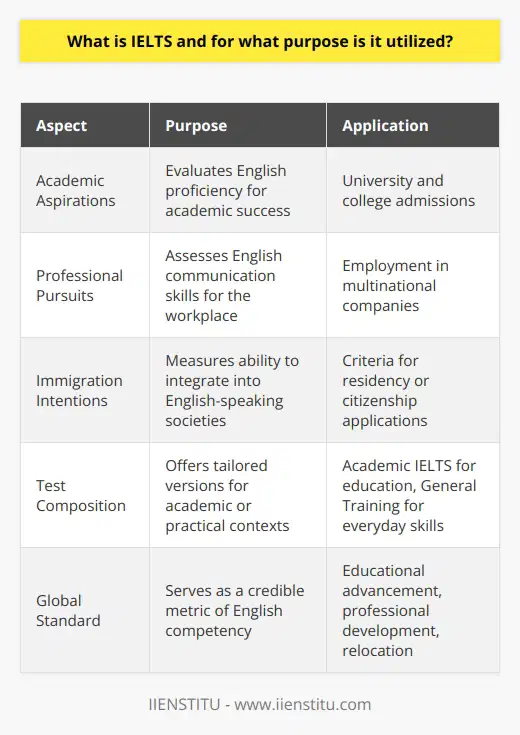
Is there a specific strategy for successfully passing the IELTS exam?
Understanding the Exam Structure
A specific strategy that significantly increases the chances of successfully passing the IELTS exam involves gaining a thorough understanding of the exam structure. The IELTS exam consists of four modules, namely Listening, Reading, Writing, and Speaking. Each module tests different skills; thus, candidates must prepare individually for each module to ensure optimal results. Through understanding the expectations of every section, candidates can develop targeted approaches to achieve their desired band scores.
Familiarizing with Question Types
Moreover, becoming familiar with the various questions types present in the IELTS exam is essential. The questions in the Listening and Reading modules, for instance, may include multiple-choice, matching, sentence completion, and diagram labelling. In the Writing module, candidates must tackle Task 1, which requires presenting information from a graph, chart or diagram, and Task 2, which entails writing an argumentative essay. Knowing the question types enables candidates to develop efficient answering strategies, leading to better time management during the exam.
Practicing with Authentic Materials
Utilizing authentic practice materials, such as IELTS sample tests, exam papers, and other resources endorsed by the British Council and IDP, allows for the most effective preparation. These materials provide a realistic representation of the actual IELTS exam, including its style, format, and difficulty level. By practicing with authentic materials, candidates develop a deeper understanding of the exam content, as well as the necessary skills and strategies to succeed in each module.
Enhancing Language Skills
Naturally, honing English language skills remains crucial in achieving success in the IELTS exam. This means that candidates should focus on enhancing their vocabulary, grammar, pronunciation, and fluency. To do so, engage in various activities, such as reading newspapers, magazines, and books in English, listening to podcasts or watching videos, and writing essays on different topics. Participating in conversation groups, practicing with language exchange partners, and seeking feedback from experts can aid in improving speaking abilities.
Setting Realistic Goals
Lastly, setting realistic goals plays an essential role in ensuring a successful IELTS exam experience. Candidates should establish clear objectives, such as aiming for a specific band score or improving in identified weak areas. Systematic planning, time management, and regular self-assessment can further support progress toward achieving these goals. By maintaining discipline, consistency, and motivation, candidates can maximize their chances of success in the IELTS exam.
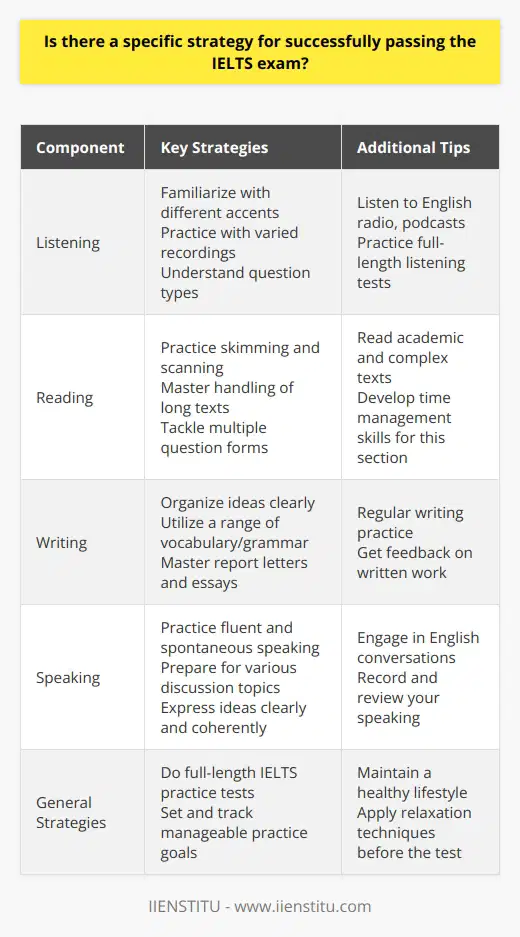
In terms of difficulty, how does the IELTS compare to other language proficiency examinations?
Comparing IELTS to Other Language Examinations
Assessing Difficulty Levels
In order to determine the relative difficulty of the International English Language Testing System (IELTS) compared to other language proficiency examinations, it is essential to evaluate some key aspects of the tests. These aspects include the test format, the skills assessed, and the scoring system of each exam.
Test Formats and Skills Assessed
The IELTS, Test of English as a Foreign Language (TOEFL), and Cambridge English Qualifications (CEQ) are three well-known English language proficiency tests. The IELTS and TOEFL have different formats, with IELTS primarily employing paper-based tasks, while TOEFL uses computer-based exercises. Moreover, the IELTS assesses four skills: listening, reading, writing, and speaking, similar to TOEFL and CEQ. However, CEQ offers separate exams for different skill combinations, allowing test-takers to focus on their strengths.
Scoring Systems
IELTS uses a 9-band scale, with each band corresponding to specific language abilities. TOEFL has a 120-point scoring system, and CEQ presents results in grades ranging from A to C. Understanding the scoring system of each exam and comparing the average scores required for admission to universities can provide an indication of the relative difficulty levels.
Overall Difficulty Assessment
Comparing the IELTS to other language proficiency tests reveals that the level of difficulty is subjective and depends on various factors. Factors such as individual strengths, preferred formats, and preparation time can influence the perceived difficulty. In general, each test offers unique challenges and benefits for test-takers, and no single exam can be deemed universally more or less difficult than others.

What is the main purpose of IELTS?
Subheading: IELTS Overview
The International English Language Testing System (IELTS) serves a critical role in determining the proficiency of non-native English speakers. As a globally recognized standardized test, IELTS encompasses four essential language skills: listening, reading, writing, and speaking.
Subheading: Academic and Professional Applications
The main purpose of IELTS is to evaluate the individual's ability to communicate effectively in English, which is crucial for academic and professional success in English-speaking countries. In the academic setting, universities and educational institutions often require IELTS scores from prospective students, ensuring they possess adequate language skills for their studies. Consequently, a high score indicates a student's readiness to partake in advanced-level academic coursework.
Subheading: Immigration Purposes
In addition to academic and professional contexts, IELTS plays a significant role in immigration. English-speaking countries, such as Australia, Canada, New Zealand, and the United Kingdom, rely on IELTS scores to determine the eligibility of applicants seeking permanent residency or citizenship. These countries consider language proficiency a vital factor in assimilating candidates within their society and contributing productively to the local economy.
Subheading: Personal Growth and Development
Beyond serving institutional objectives, IELTS also aids individuals in self-assessment. Test-takers can identify their language competencies, as well as areas that require further enhancement. By establishing a benchmark, IELTS assists learners in measuring their progress and helping them develop effective strategies for improvement.
In conclusion, the main purpose of IELTS is multifaceted, addressing academic, professional, immigration, and personal development goals. As an internationally recognized assessment tool, IELTS offers a comprehensive evaluation of English language proficiency, enabling individuals and institutions to make informed decisions and promote effective communication within English-speaking environments.
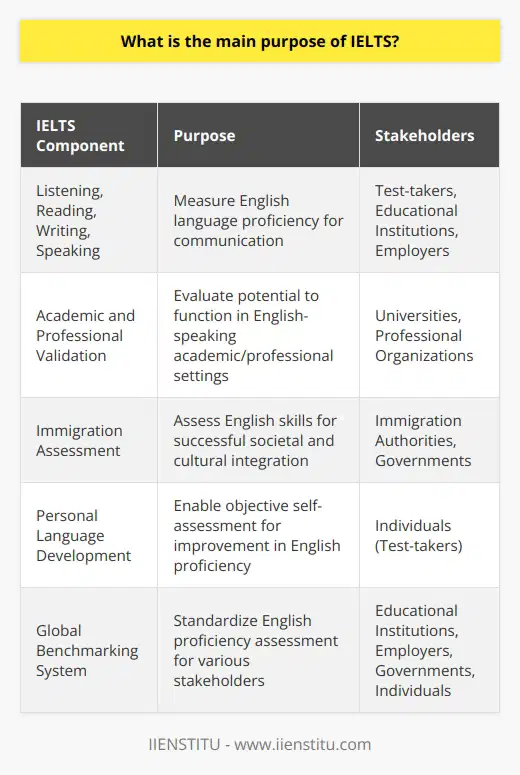
How do the four sections of the IELTS test contribute to an overall assessment of English language proficiency?
Testing Skills in Four Domains
The International English Language Testing System (IELTS) assesses English language proficiency through four distinct yet interconnected sections, which include listening, reading, writing, and speaking. By evaluating skills in these four domains, the IELTS test can provide a comprehensive appraisal of an individual's ability to understand and communicate effectively in English in various contexts.
Listening: Evaluating Comprehension
The listening section of the IELTS test aims to gauge an individual's ability to understand spoken English in diverse situations. It focuses on key competencies, such as the capacity to interpret main ideas, extract specific information, and recognize the speaker's purpose or point of view. This section helps to ensure candidates possess essential language skills required for academic and professional settings where the comprehension of spoken English is crucial.
Reading: Measuring Textual Analysis
The reading section evaluates a candidate's ability to interpret and engage with written English. The focus is on the analysis of texts, assessing skills such as the ability to identify main ideas, extract specific information, and differentiate between facts and opinions. By testing these skills, the IELTS ensures that test-takers have the essential skills necessary for successfully navigating academic and professional environments where the comprehension of written English is vital.
Writing: Assessing Expression and Organization
The writing section assesses an individual's ability to generate coherent and accurate written English. This domain tests one's capacity for organizing information, presenting clear and logical arguments, exhibiting grammatical precision, and utilizing appropriate vocabulary. As both academic and professional settings require effective written communication, this section helps guarantee that IELTS test-takers can adequately express themselves in English.
Speaking: Analyzing Oral Communication
The speaking section evaluates an individual’s ability to express ideas confidently and coherently in spoken English. It examines fluency, accuracy, and the complexity of language. Crucially, this section assesses a candidate's capacity to engage in conversations, express opinions, and respond to questions effectively. Consequently, it helps to ensure that one can thrive in settings where strong oral communication abilities in English are necessary.
In conclusion, the four distinct sections of the IELTS test - listening, reading, writing, and speaking - effectively assess the breadth of an individual’s English language proficiency. By evaluating these areas, the IELTS test ensures that candidates possess the necessary language competencies to excel in academic and professional environments where English plays a pivotal role in communication.
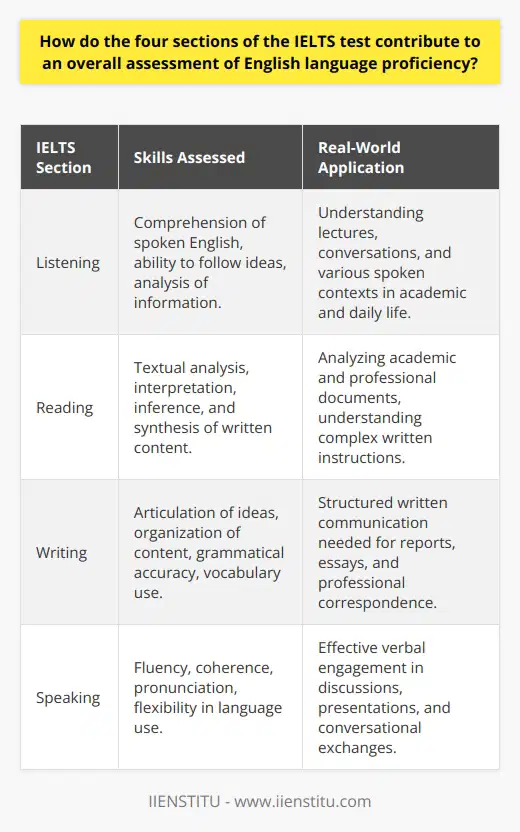
In regard to the IELTS exam, how does the combined usage of listening, reading, writing, and speaking skills contribute to accurate and effective communication?
Significance of Integrated Skill Approach
In the context of the IELTS exam, the combined usage of listening, reading, writing, and speaking skills plays an essential role in ensuring accurate and effective communication. Individually, each skill enables test-takers to perform specific tasks necessary for successful communication, but it is the integration of all four that ultimately leads to proficient communication.
Role of Listening Skills
To begin with, listening skills are crucial for accurately understanding and interpreting spoken language from various sources. In the IELTS exam, test-takers need to comprehend the content, grasp key ideas, and identify the context to respond effectively to a diverse array of language input, such as lectures, discussions, and conversations.
Importance of Reading Skills
Similarly, reading skills are vital for making sense of written language in various texts, ranging from academic articles to everyday materials like newspapers and advertisements. The IELTS exam evaluates a candidate's ability to identify main ideas, supporting details, and the writer's overall purpose, which contributes to a holistic understanding of written communication.
Essence of Writing Skills
Furthermore, writing skills constitute an essential component of effective communication for expressing ideas, opinions, and information in a coherent, cohesive, and well-structured manner. The IELTS exam evaluates a candidate's ability to organize thoughts, use appropriate vocabulary and grammar, and adhere to text conventions in different writing genres, such as essays, reports, or letters.
Function of Speaking Skills
Lastly, speaking skills are indispensable for active participation in real-life situations that require clear, intelligible, and appropriate oral communication. In the IELTS exam, candidates must demonstrate their fluency, accuracy, and ability to engage in various types of spoken interactions, including discussing familiar topics, presenting arguments, and handling complex questions.
Integration of Skills for Effective Communication
In conclusion, the combined usage of listening, reading, writing, and speaking skills significantly contributes to accurate and effective communication in the IELTS exam. The integration of all four skills equips test-takers with the necessary tools to understand, interpret, and convey meaning in diverse contexts, ultimately leading to better overall performance not only in the exam but also in real-life communication situations.
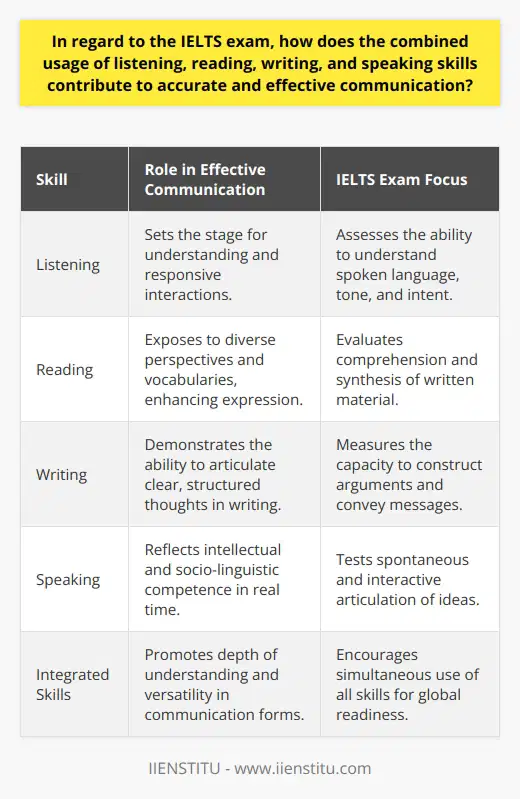
What factors determine the level of difficulty experienced by individual test-takers when attempting the IELTS?
Factors Affecting IELTS Difficulty
Individual Test-taker Background
One major factor determining the level of difficulty experienced by individual test-takers when attempting the IELTS is the individual's linguistic background. Specifically, the exposure to English language in their environment, the age of acquiring English proficiency, and the quality of instruction received greatly affect their ability to understand, interpret, and respond effectively in the exam.
Test Preparation Strategies
Another factor is the test preparation strategies adopted by the individual. Consistent practice, using authentic IELTS materials, and engaging in activities that improve their listening, reading, writing, and speaking skills can significantly impact the level of difficulty experienced while taking the exam. Furthermore, being familiar with the test structure, question formats, and scoring criteria can make the students more comfortable and reduce the test anxiety.
Cognitive Abilities
Additionally, individual cognitive abilities, such as working memory capacity, information processing speed, and analytical skills, also influence the difficulty experienced by test-takers. These factors play a crucial role in the ability to comprehend complex texts, analyze and solve problems, and express thoughts and ideas effectively, which are key components of the IELTS test.
Test Anxiety
Lastly, test anxiety is another significant factor that determines the level of difficulty experienced by IELTS test-takers. Anxiety can have negative effects on an individual's concentration, ability to recall information, and overall performance during the test. As a result, effective stress management and relaxation techniques become crucial in overcoming test anxiety and enhancing the test-taking experience.
Conclusion
In conclusion, various factors like linguistic background, test preparation strategies, cognitive abilities, and test anxiety determine the level of difficulty experienced by individual test-takers when attempting the IELTS. These factors are essential to acknowledge and address to ensure a successful performance in the test.
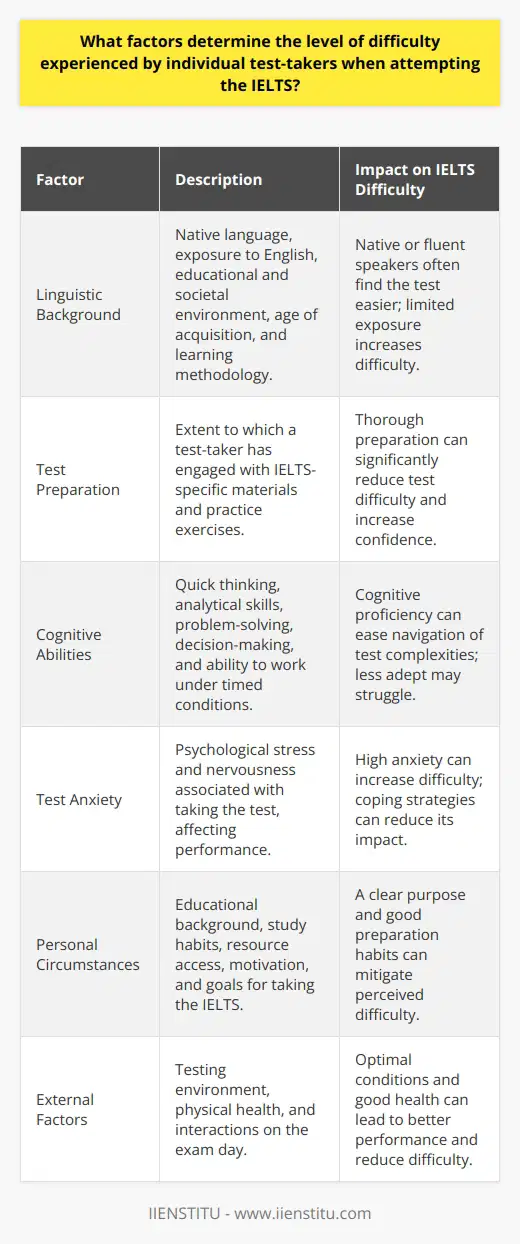
How does the IELTS scoring system measure the gradation of language proficiency and its corresponding practical implications?
IELTS Scoring System
The IELTS (International English Language Testing System) scoring system measures language proficiency based on a series of standardized criteria in four main categories: listening, reading, writing, and speaking. Each category receives a separate band score, traditionally ranging from 0 to 9, with half-point intervals (e.g., 6.5, 7, 7.5).
Gradation in Language Proficiency
The gradation in language proficiency is determined by the range of these band scores, catering to various English competencies. A score of 0 represents a complete lack of proficiency, while a score of 9 indicates an expert in the English language. Intermediate scores represent the varying levels of ability between these two extremes.
Practical Implications of IELTS Scores
Higher Education Institutions
Universities and colleges around the world use IELTS scores to screen prospective students' English language proficiency. This ensures that students can handle the rigors of academic coursework and participate effectively in classroom discussions.
Employment Opportunities
Many multinational corporations and organizations require IELTS scores for their employees, particularly in positions where English language proficiency is a critical skill. A higher IELTS score often translates into improved job prospects and career advancement opportunities.
Immigration Purposes
IELTS scores serve as a benchmark for immigration authorities in countries such as Canada, the United Kingdom, and Australia. These countries have specific language proficiency requirements, and a higher IELTS score can improve an applicant's chances of obtaining a visa or residency.
Relationship Between IELTS Scores and Practical Language Use
While IELTS scores provide an essential measurement of language proficiency, it is crucial to understand the correlation between the scores and practical implications. For example, a candidate with an IELTS score of 6.5 might effectively engage in everyday conversations but could struggle with more demanding academic or professional tasks. In contrast, a candidate with an IELTS score of 8.5 may be well-equipped to handle complex language situations, demonstrating higher language proficiency and enhanced practical implications.
In conclusion, the IELTS scoring system effectively measures the gradation of language proficiency, with scores having a direct impact on higher education, employment opportunities, and immigration processes. Understanding these practical implications is critical for both test-takers and institutions that rely on IELTS scores as a benchmark for language proficiency.
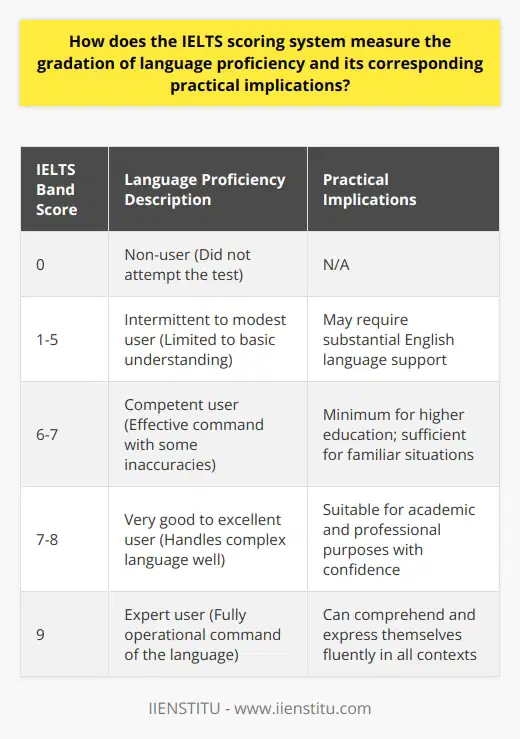
In what ways does the IELTS exam contribute to educational and professional opportunities for candidates seeking admission or employment in English-speaking countries?
Enhancing Educational Opportunities
One of the significant ways the IELTS exam contributes to educational opportunities is by acting as a gatekeeper for admission into English-speaking institutions. Universities and colleges in these countries often require a minimum IELTS score as a prerequisite for acceptance, ensuring that the candidate possesses the desired level of English language proficiency. The test score thus becomes a crucial element that enables candidates to receive higher education in prestigious institutions worldwide, which further translates into better job prospects and possibilities for career growth.
Bridging Professional Advancements
In the professional sphere, the IELTS exam serves as a testament to a candidate's English language skills, opening doors to career advancement and opportunities in English-speaking countries. Many employers view a high IELTS score as a guarantee of an applicant's ability to effectively communicate and contribute positively to the workplace environment. Notably, immigration authorities often utilize the IELTS exam as a vital factor in determining an individual's eligibility for work permits and visas. Consequently, achieving a competitive IELTS score can facilitate smoother transitions to new international job markets while providing strong evidence of a candidate's language aptitude.
Fostering Global Networking
In addition to academic and professional growth, the IELTS exam also enables candidates to cultivate global networks, which prove to be valuable assets throughout their careers. By attending English-speaking universities and working in organizations where English is the primary language, candidates gain access to diverse communities of academics, professionals, and entrepreneurs. Being proficient in English assists in fostering stronger connections, collaborating effectively in multinational teams, and participating in international conferences and seminars. This global networking ultimately contributes to candidates' educational and professional success, as they can better understand and capitalize on global trends, ideas, and opportunities.
In summary, the IELTS exam paves the way for individuals seeking educational and professional opportunities in English-speaking countries by acting as a benchmark for English language proficiency. A high IELTS score not only ensures admission into renowned academic institutions but also improves the candidate's job prospects, while facilitating global networking and international exposure. Overall, the test serves as a stepping stone to greater possibilities, enabling candidates to achieve their career aspirations and excel in the 21st-century global economy.
